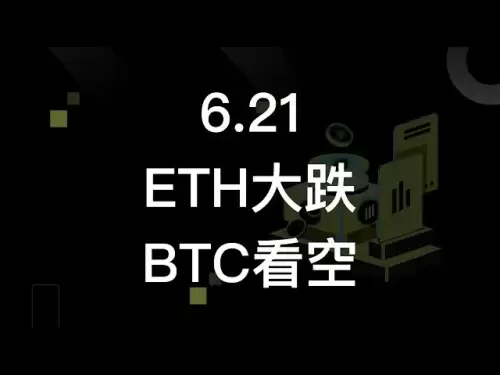 |
|
 |
|
 |
|
 |
|
 |
|
 |
|
 |
|
 |
|
 |
|
 |
|
 |
|
 |
|
 |
|
 |
|
 |
|
Cryptocurrency News Articles
Navigating Crypto Tides: Bitcoin & Ethereum Options Expiration and Market Volatility
Jun 21, 2025 at 09:03 am
Decoding the impact of Bitcoin and Ethereum options expirations on market volatility amid geopolitical tensions and Fed policy.

Navigating Crypto Tides: Bitcoin & Ethereum Options Expiration and Market Volatility
Buckle up, crypto enthusiasts! The Bitcoin and Ethereum options market is buzzing with activity as billions in contracts expire, stirring up volatility. Let's dive into what this means for your portfolio.
Billions on the Line: BTC and ETH Options Expiration
Over $4.1 billion in Bitcoin (BTC) and Ethereum (ETH) options contracts recently expired, sending ripples through the crypto market. Bitcoin options accounted for a significant $3.5 billion, while Ethereum options totaled $565 million. These expirations aren't just numbers; they reflect trader sentiment and market expectations, setting the stage for potential price swings.
Decoding the Data: Put-to-Call Ratios and Max Pain
Understanding the put-to-call ratios and max pain levels provides valuable insights. For Bitcoin, a put-to-call ratio of 1.00 indicates a balanced outlook, with traders split between bullish and bearish positions. The max pain level of $105,000 suggests a point where the most option holders would experience losses if the price remains stagnant. Ethereum, on the other hand, shows a more bullish sentiment with a put-to-call ratio of 0.69 and a max pain level of $2,600.
Max Pain Explained
“Max pain” is the price at which the greatest number of options contracts expire worthless. Prices often gravitate toward this point during expiration periods, leading to temporary volatility as traders and algorithms adjust their positions.
Short-Term Jitters vs. Long-Term Optimism
While short-term volatility is expected, many traders remain optimistic about the long-term prospects of Bitcoin and Ethereum. As Deribit analysts noted, Bitcoin shows balanced positioning near max pain, while Ethereum leans bullish. This suggests that while short-term price fluctuations are likely, a major market crash is not guaranteed.
Geopolitical Risks and Fed Signals Add Complexity
The crypto market doesn't operate in isolation. Recent statements from Federal Reserve Chair Jerome Powell, signaling caution regarding rate cuts, and rising geopolitical tensions, particularly in the Middle East, have added to market uncertainty. Traders are hedging against potential downside risks in the short term while maintaining hope for a recovery later in the year.
Looking Ahead: What's Next for BTC and ETH?
With Bitcoin and Ethereum trading below their respective max pain levels, the future is uncertain. However, historical patterns suggest that markets often stabilize after options expirations. Keep an eye on whether prices gravitate toward the max pain levels, which could signal short-term recoveries. Failure to hold current levels may indicate further consolidation.
My Two Satoshis: A Personal Take
While the expiration event undoubtedly injects volatility, it's crucial to zoom out and view the bigger picture. The increasing institutional interest and growing adoption of crypto suggest that these short-term fluctuations are merely bumps on the road to long-term growth. Remember when everyone panicked about Bitcoin crashing below $30,000? Look where we are now!
Final Thoughts
Navigating the crypto market requires a blend of caution and optimism. While the expiration of Bitcoin and Ethereum options may cause short-term turbulence, it's unlikely to define the year. Traders are walking a tightrope between Fed policy, global conflicts, and technical indicators, but many remain hopeful for a Q4 rebound. So, stay informed, stay alert, and get ready for an interesting ride!
Disclaimer:info@kdj.com
The information provided is not trading advice. kdj.com does not assume any responsibility for any investments made based on the information provided in this article. Cryptocurrencies are highly volatile and it is highly recommended that you invest with caution after thorough research!
If you believe that the content used on this website infringes your copyright, please contact us immediately (info@kdj.com) and we will delete it promptly.






























































